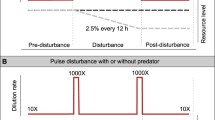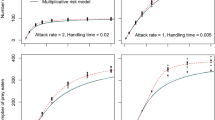Abstract
Protozoa are key components of a wide range of ecosystems, but ecological models that incorporate these microbes often suffer from poor parameterisation, specifically of top-level predator loss rates. We (1) suggest that top-level predator mortality is prey-dependent, (2) provide a novel approach to assess this response, and (3) illustrate the ecological relevance of these findings. Ciliates, Paramecium caudatum (prey) and Didinium nasutum (predator), were used to evaluate predator mortality at varying prey levels. To assess mortality, multiple (>100) predators were individually examined (in 2-ml wells), daily (for 3 days), between 0 and 120 preys ml−1. Data were used to determine non-linear mortality and growth responses over a range of prey abundances. The responses, plus literature data were then used to parameterise a predator–prey model, based on the Rosenzweig–MacArthur structure. The model assessed the impact of variable and three levels of constant (high, average and low) mortality rates on P. caudatum–D. nasutum population dynamics. Our method to determine variable mortality rate revealed a strong concave decline in mortality with increasing prey abundance. The model indicated: (1) high- and low-constant mortality rates yielded dynamics that deviate substantially from those obtained from a variable rate; (2) average mortality rate superficially produced dynamics similar to the variable rate, but there were differences in the period of predator–prey cycles, and the lowest abundance of prey and predators (by ~2 orders of magnitude). The differences between incorporating variable and constant mortality rate indicate that including a variable rate could substantially improve microbial-based ecological models.






Similar content being viewed by others
References
ASTM (1989) Standard guide for conducting acute toxicity tests with fishes, macroinvertebrates and amphibians. Annual Book of ASTM Standards, vol. 11.04. ASTM International, West Conshohocken, PA. pp 379–397
Azam F, Fenchel T, Field JG, Gray JS, Meyer-Reil LA, Thingstad F (1983) The ecological role of water-column microbes in the sea. Mar Ecol Prog Ser 10:257–263
Blackford JC, Allen JI, Gilbert FJ (2004) Ecosysem dynamics at six contrasting sites: a generic modelling study. J Mar Syst 52:191–215
Calbet A (2008) The trophic roles of microzooplankton in marine systems. ICES J Mar Sci 65:325–331
Dodson SI (1972) Mortality in a population of Daphnia rosea. Ecology 53:1011–1023
Edwards AM, Brindley J (1996) Oscilatory behaviour in a three component plankton population model. Dyn Stab Syst 11:347–369
Fenton A, Spencer M, Montagnes DJS (2010) Parameterising variable assimilation efficiency in predator–prey models. Oikos 119:1000–1010
Fukuwaka M, Suzuki T (2002) Early sea mortality of mark-recaptured juvenile chum salmon in open coastal waters. J Fish Biol 60:3–12
Fulton EA, Smith ADM, Johnson CR (2002) Mortality and predation in ecosystem models: is it important how these are expressed? Ecol Model 169:157–178
Gause GF (1934) Experimental analysis of Vito Volterra’s mathematical theory of the struggle for existence. Science 79:16–17
Gerhard GS (2001) Caloric restriction in nonmammalian models. J Anti-Aging Sci 4:205–213
Ginzberg LR (1998) Assuming reproduction to be a function of consumption raises doubts about some popular-predator prey models. J Anim Ecol 67:325–327
Harrison GW (1995) Comparing predator-prey models to Luckinbill’s experiment with Didinium and Paramecium. Ecology 76:357–374
Hewett SW (1980) Prey dependent cell size in a protozoan predator. J Protozool 27:311–313
Hewett SW (1988) Predation by Didinium nasutum: effects of predator and prey size. Ecology 69:135–145
Luckinbill LS (1972) Coexistence in laboratory populations of Paramecium aurelia and its predator Didinium nasutum. Ecology 54:1320–1327
MacLulich DA (1937) Fluctuations in the numbers of the varying hare (Lepus americanus). Univ Tor Stud Biol Ser 43:1–136
Ratsak CH, Maarsen KA, Kooijman SALM (1996) Effects of protozoa on carbon mineralization in activated sludge. Water Res 30:1–12
Steel JH, Henderson EW (1981) A simple plankton model. Am Nat 117:676–691
Turchin P (2003) Complex population dynamics: a theoretical/empirical synthesis. Princeton University Press, Princeton
Acknowledgements
The authors thank Matt Spencer for statistical advice the students of BIOL 761 “Dynamic Population Modelling” at Liverpool University who critically evaluated this work. The study was supported by a British Ecological Society Small Project Grant (3061/3769), awarded to AF.
Author information
Authors and Affiliations
Corresponding author
Rights and permissions
About this article
Cite this article
Minter, E.J.A., Fenton, A., Cooper, J. et al. Prey-Dependent Mortality Rate: A Critical Parameter in Microbial Models. Microb Ecol 62, 155–161 (2011). https://doi.org/10.1007/s00248-011-9836-5
Received:
Accepted:
Published:
Issue Date:
DOI: https://doi.org/10.1007/s00248-011-9836-5




